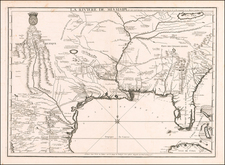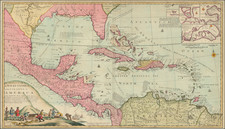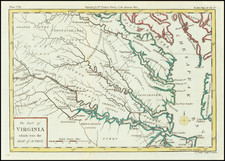Attractive unrecorded broadside for an auction of three buildings in the heart of downtown Atlanta, which now includes Underground Atlanta.
The three contiguous parcels were owned at the time by the Foote & Davies Printing Company. Founded in 1887, Foote & Davies was at the time a major Atlanta printing and publishing house. Centrally located on a block bounded by Alabama and Pryor Streets, Alabama Avenue, and Kenny's Alley, Foote & Davies were in close proximity to the Union Passenger Depot and other rail facilities. The location was thus "admirably adapted for wholesale and manufacturing purposes."
The broadside consists of a central plat depicting the block in question, including the boundaries and dimensions of the parcels being auctioned and an inset view of the structures situated thereon, including the Foote & Davies plant. Three columns of text describe the properties, emphasize their commercial potential, and outline the terms of sale. The good size, the variety of typefaces and the inset view all combine to render the image rather appealing.
This block and the surrounding area were rapidly transformed in the years after the auction, as numerous railroad viaducts began to be connected to create an elevated pedestrian mall. By the end of the 1920s a several-block area had been elevated by a full story, and businesses moved their operations up a floor to front on the new mall. The original store fronts were relegated to basements, and this subterranean area sank into obscurity until it was rediscovered in the 1960s and transformed into "Underground Atlanta."
The buildings comprising Underground Atlanta were constructed during the city's post-Civil War Reconstruction Era boom. In 1869, the Georgia Railroad freight depot was constructed. The depot, which stands at the entrance of Underground Atlanta, remains the oldest building in downtown Atlanta. An electric streetcar was installed in 1889 to points South, and by 1900 the depot was serving 100 trains per day with direct service between Atlanta and New York City; Cincinnati, Ohio; Chattanooga, Tennessee; Knoxville, Augusta, Georgia; Macon, Georgia; and Columbus, Georgia. By 1910, several iron bridges had been built to cross the railroad tracks at Union Street. At the suggestion of Atlanta architect Haralson Bleckley, the bridges were rebuilt in concrete and connected by a linear mall between them. Eventually, Bleckley envisioned public plazas between the bridges, but only one, Plaza Park (later Peachtree Fountains Plaza), was ever built.
As construction took place in the 1920s, merchants began to move their operations to the second floor of their buildings, and turned the original ground floors' storefronts into basements for storage and service. Given that this occurred during Prohibition, and the fact that these "basements" were relatively obscured from the city above, some of the basements became sites for speakeasys and juke joints, with music and illegal drinking a common occurrence. One of the first mentions of the area is in the opening lines of Bessie Smith's "Atlanta Blues" which documents its importance as an entertainment district:
The broadsides' rarity and visual appeal, and the prime location of the area depicted, combine to render this a most desirable artifact from Atlanta's boom in the decades after the Civil War.












![[ Port Royal, South Carolina ]](https://storage.googleapis.com/raremaps/img/small/81298.jpg)
![[Hand Drawn Map] Le Golfe de Mexique avec les Pays Circonvoisins](https://storage.googleapis.com/raremaps/img/small/91580.jpg)
![Map of the States of North & South Carolina [Large Charleston Inset]](https://storage.googleapis.com/raremaps/img/small/91846.jpg)